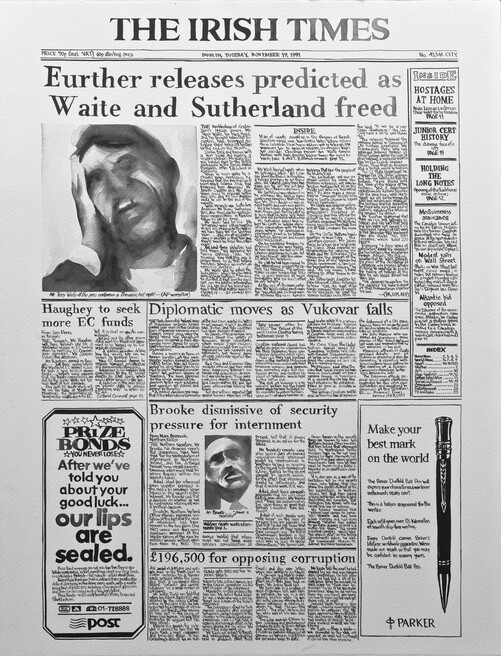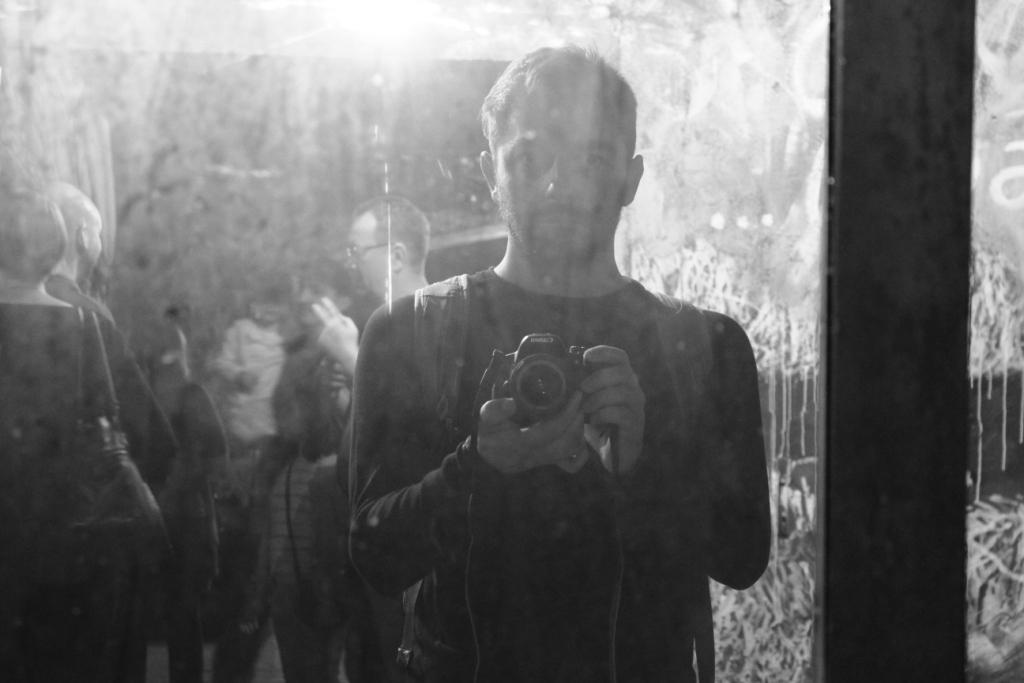Vladimir Miladinović
Bereich: Medienkunst
Key Facts
Nationalität
SerbienBereich
MedienkunstWohnort
BelgradEmpfehlende Institution
freiraum Q21 INTERNATIONALZeitraum
Jänner 2016 - Jänner 2016*1981 in Belgrade, Serbia, lives in Belgrade, Serbia
POSITION
2007: Status of Individual Artist
2010: Member of the art/theory group “Four Faces of Omarska”
2011: Co founder of “Initiative for contemporary art and theory”
EDUCATION
1996 – ‘00: High School of Fine Arts, Niš
2000 – ‘05: M.A. Faculty of Applied Arts, University of Belgrade
2009 - ongoing: PhD in Theory of Arts and Media, Interdisciplinary Studies, University of Belgrade
2011: International Summer Academy of Fine Arts, Salzburg, Austria
AWARDS/PRIZES
2013 Nomination for the Henkel Art Award, Serbia
2012 Award of the 53rd October salon, Belgrade, Serbia
2011 Finalist of the “Vladimir Veličković” drawing fund, Galery HAOS, Belgrade, Serbia
SOLO EXHIBITIONS
2015 „Rendered history“, Galerry Moderna, Subotica, Serbia
2014 „Kninjas - Knights of Srpska Krajina“, MKC - Multimedial Cultural Center , Split, Croatia
2014 „Kninjas - Knights of Srpska Krajina“, Cultural center Ribnica, Kraljevo, Serbia
2012 “Golden age”, Magacin u Kraljevića Marka, Kontekst kolektiv, Belgrade, Serbia
2011 “Worker in protest”, Mesna zajednica Novi Beograd, Kontekst kolektiv, Belgrade, Serbia
2008 “No Gun No Respect”, Gallery SULUJ, Belgrade, Serbia
GROUP EXHIBITIONS (Selection)
2015 „A Moving Identity“, Cambridge Science Park-NW Gallery, Cambridge, UK
„Tudje haljine“, Lazareti, Dubrovnik, Croatia
Photodocs, Münchner Stadtmuseum, Munich, Germany
Prague Quadrennial of Performance Design and Space, „Shared Space – Music Weather Politics 2013 – 2016“, Prague, Chech Republic
„Resolution 827 “, SMBA - Stedelijk Museum Bureau Amsterdam(Curated by Zoran Erić and Jelle Bouwhuis), Amsterdam, Nederlands
„Etiquette: Good Maintenance And Polite Behaviour“, New acquisitions in the October Salon Collection (Curated by Aleksandra Estela Bjelica), Cultural Center Belgrade, Belgrade, Serbia
Invisible Violence (Curated by Blanca De la Torre, Zoran Erić, Seamus Kealy) Künstlerhaus, Salzburg, Austria
2014 Work presentation of artist in residency, Austellungsraum des Bundeskanzleramtes, Wien, Austria
Nes(a)vršene strukture, Cultural Center Belgrade – Gallery Podroom, Belgrade, Serbia
Invisible Violence (Curated by Blanca De la Torre, Zoran Erić, Seamus Kealy), Artium, Basque Museum - Centre of Contemporary Art, Vitoria, Spain
Invisible Violence (Curated by Blanca De la Torre, Zoran Erić, Seamus Kealy), Museum of Contemporary Art, Belgrade, Serbia
27. Memorial Nadežda Petrović, „Ko to tamo peva..“ (Curated by Dejan Sretenović), Čačak, Serbia
Trip to Europe / The missing amount, (Curated by Mia David&Zorana Djakovic Minniti) Ehemaliges Tschechisches Kulturzentrum, Berlin, Germany
Trip to Europe / I want to speak about war, (Curated by Mia David&Zorana Djakovic Minniti), Klovićevi Dvori Gallery, Zagreb, Croatia
Trip to Europe / Peace, Peace, Peace, (Curated by Mia David&Zorana Djakovic Minniti), Collegium Artisticum, Sarajevo, Bosnia and Herzegovina
Trip To Europe / With Herous and Witnesses, (Curated by Mia David&Zorana Djakovic Minniti), Moderna galerija, Subotica, Serbia
2013 Der Weg Nach Europa mit Princip(ien) oder ohne, (Curated by Mia David&Zorana Djakovic minniti), Palais Porcia, Vienna, Austria
25. Adria Art Annale, Dioklecijanovi podrumi, Split, Croatia
4. Biennial of Visual Arts, Čacak, Serbia
Mediterranea 16 Young Artists Biennial „Errors Allowed“ (Curated by Charlotte Bank, Alessandro Castiglioni, Nadira Laggoune, Delphine Leccas, Slobodne Veze/Loose Associations, Marco Trulli, Claudio Zecchi.) Ancona, Italy
“Awkwardness in culture” (Curated by Jana Stojaković), Gallery Ozon, Belgrade, Serbia
2012 “Places of Memory - Fields of Vision” (Curated by Syrago Tsiara), Contemporary Art Center, Thessaloniki, Greece
Exhibition of the laureates of “Vladimir Veličković fund for drawing”, Galery HAOS, Belgrade, Serbia
53rd October salon “Good life”, (Curated by Branko Dimitrijevic and Mika Hannula) Belgrade, Serbia
15th Biennial of Art “De/rekonstrukcija: prostor/vreme/sećanje”, Pančevo, Serbia (Curated by Nikola Dedić and Aneta Stojnić) – WG Four faces of Omarska “Working gathering: film bulletin Četiri lica Omarske” – projection of raw video material and discussion,
“Working group SC: Politics of (de) marking of suffering places”, [BLOK] in correspondence with WG Four faces of Omarska, Public working meeting, Student center, Zagreb,Croatia
2011 “Hands aufs Hartz”, Student exhibition of the International Summer Academy of Fine Arts, Festungspiele, Salzburg, Austria
“Golden age”, Sound and Visions - Multimedia Festival, Majdanpek, Serbia
2009 “Anonymous Drawings No 10”, International Drawings Exhibition, Berlin, Germany
“Without Borders?”, some critical reflections on European global border conditions, Group Exhibition, Magacin Kraljevica Marka, Belgrade
“Multipoint”, Workshop exhibition, Gallery Universum, Nitra, Slovakia
“Niš Art Foundation”, Philip Morris Inc. Serbia, Niš, Belgrade, Novi Sad, Serbia
CONFERENCES
2014 Artist talk, “Between Facts and Fiction“, ZFD-Forum Ziviler Friedensdienst, Pristina, Kosovo
2012 “Living death camp and Forensic Aesthetics: Where Subjagated Knowledge is Sociability Occurs”, Public working gatherings(public working meetings, lectures, discussions), Initiative Of Contemporary Art and Theory/Goldsmiths University/Centre for Cultural Decontamination, CZKD, Belgrade, Serbia
“Dealing with the Past in Serbia: What next?” (Organization: BKV Fund, Fund “Heinrich Boll”, Center for Cultural Decontamination), Peoples Library of Serbia, Belgrade, Serbia
2011 “Omarska ist das Echo von Auschwitz”, Konferenz in der Friedensstadt Linz, Zentrum der zeitgemäßen Initiativen, Linz, Austria
International conference “On the Surface: The Heritage of Mines and Mining”, University of Innsbruck, Innsbruck, Austria
International Conference “Questioning Transitional Dynamics in Re-Defining Cultural Identities in South Eastern Europe”, Peace Institute, Ljubljana, Slovenia
WORKSHOPS|RESIDENCIES
2014 Artists in Residence Programme, The Federal Ministry for Education Arts and Culture in cooperation with KKA, scholarship for residencie, Vienna, Austria
2011 Salzburg International Summer Academy of Fine Arts, “Drawing as a Wish Machine”, Christoph Schafer, Salzburg, Austria
2009 “Without borders?” Some critical reflections on European and global border conditions - International workshop, Gallery Kontekst – Belgrade, Serbia
“Multipoint”, International Art Symposium, Nitra, Slovakia
2008 International workshop “The Return of the Gastarbaiters”, Public Space, Požarevac, Serbia
LECTURES
2012 “Theories of the Culture of Memory” – Lecture was held within the platform “Culture of memory” at the 15th Biennial of Art “De/rekonstrukcija: prostor/vreme/sećanje”, Pančevo, Serbia
PUBLICATIONS
2014 „Rendered History“, Forum ZFD, Belgrade, Serbia
2012 “Externalization of Memory through Visual Media”, Theater Film Television, Službeni Glasnik, Belgrade, Serbia
2011 “Politicization of Memory Through the Monument Culture”, Paper is available at the website of the project Questioning Transitional Dynamics in Re-Defining Cultural Identities in South Eastern Europe <link http: rci.mirovni-institut.si docs aso _blank external-link-new-window>rci.mirovni-institut.si/Docs/ASO %202010%20studwork%20Miladinovic.pdf
PUBLIC COLLECTIONS
2015 Museum of Contemporary Art Belgrade, Permanent Collection
2014 October Salon collection, Belgrade Cultural Center
In the beginning of 2012 I started a project entitled Rendered History. One of the main goals of the project was to go into the archive of a local newspapers and make a research towards the period of the 1990ies. Special attention was given to the articles that are related to the war in Yugoslavia.
During my residency I would like to develop the project into a context of a local Austrian daily newspapers. It would be of great interest for the project to examine the relation of Austrian based media toward the conflict in YU by that time. Especially because of the fact that many people from the region of ex-Yugoslavia now live in Austria, and many of them came as collateral of the war. By that kind of comparison we would be able to make a potential for a new critical relation toward dissemination of ex-Yugoslavia, which in a way created a path for a new exodus of population into the western parts of the EU.
Residency would include a daily research of a newspapers archive, research of the articles related to the war in Yugoslavia.





